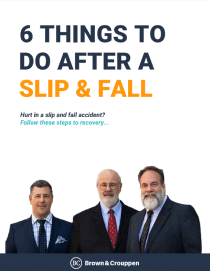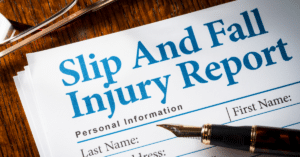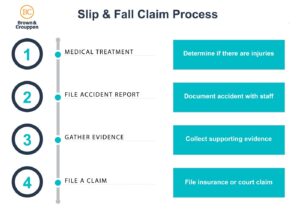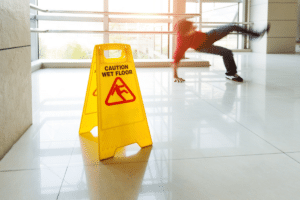According to Injury Facts, fall injuries cause 21 percent of preventable injury-related deaths in the United States — the same percentage as motor vehicle accidents. Falls are the leading cause of non-fatal preventable injuries at 33 percent.
Property owners generally owe guests a duty to maintain a hazard-free environment. When someone slips and falls at a business, someone at the company has failed to do their job. The slip-and-fall attorneys at Brown & Crouppen help clients hold businesses accountable when their negligence leads to injuries from falls.

Use our checklist to learn what to do after a fall and understand key legal considerations.
Slip and Fall Settlement Examples
At Brown & Crouppen, we helped hundreds of clients recover compensation after their slip and fall accident. Some of our notable slip and fall settlement examples include the following:
- $2M slip and fall verdict as a result of an accident in a snow-covered parking lot.
- $637.5K slip and fall as a result of apartment complex negligence
- $300K slip and fall settlement for a houseguest who fell down stairs
- $155K slip and fall settlement for a client who feel at a supermarket
Depending on the circumstances of your accident, you may be eligible to recover compensation for medical bills, lost wages, and non-economic damages (such as pain and suffering).
How Is A Slip-And-Fall Settlement Calculated?
Calculating a slip and fall settlement requires taking the following factors into account:
- The lifelong impact of the fall injuries
- The available insurance coverage and assets of the defendant
- The defendant’s conduct leading up to and surrounding the fall
- Whether the fall victim shares fault for the fall
The damages that may be available after a fall include the following:
- Medical expenses: Your settlement will include verifiable medical expenses such as hospitalization, doctor bills, therapy, rehabilitation, and domestic services. Projected ongoing costs stemming from your injuries will also be considered when negotiating a settlement.
- Lost wages: Lost wages include the income forfeited due to being out of work during recovery and the disability itself — even if it is permanent.
- Non-economic damages: Non-economic damages cover the injury’s impact on your quality of life and include pain and suffering, disfigurement, and loss of enjoyment of life. These damages are subjective and challenging to negotiate, with injuries that significantly and permanently affect your life generally yielding higher awards. Examples include loss of an active lifestyle, permanent disfigurement, cognitive impairment, chronic pain, and wheelchair confinement.
- Punitive damages: Punitive damages are awarded only in extreme circumstances when clear and convincing evidence proves that the defendant intentionally caused harm or through a flagrant disregard for safety. Punitive damages are typically awarded in court, not as part of a settlement. However, if punitive damages would be recoverable through a trial, this can influence settlement negotiations.
Get Help From The Slip & Fall Attorneys at Brown & Crouppen Law Firm
The attorneys at Brown & Crouppen have been helping injured individuals in St. Louis and Kansas City slip and falls since 1979, and we have since grown into one of the largest law firms in the Midwest with a team of more than 250 legal professionals. Our award-winning attorneys have won more than $1 billion on behalf of our clients.
If you fell and sustained an injury on someone’s property, the personal injury attorneys at Brown & Crouppen can negotiate a fair settlement on your behalf.
Contact us today to get started with your case.
Frequently Asked Questions (FAQs)
Who Is Liable For My Slip-And-Fall Injuries?
While the property owner is typically the liable party, in some cases, you may be able to also hold other negligent parties liable for your slip-and-fall injuries. These include, but are not limited to, the following: These include, but are not limited to, the following: building contractors, inspectors, tenants, manufacturers, installation and repair technicians.
What Responsibilities Do Premises Owners Have?
Premises owners are responsible for removing and preventing fall hazards to ensure safety. They may be liable if these hazards cause injuries.
- Parking Lots and Sidewalks: Common slip-and-fall risks here include poor lighting, damaged wheel stops, potholes, cracks, and uneven pavement. Property owners must regularly inspect and maintain these areas to provide safe walkways. If you’ve been injured on public or private walkways, you may be eligible for compensation.
- Winter Weather: Icy conditions, especially around Kansas City’s frost dates (Oct. 29 to April 10) and St. Louis (Oct. 22 to April 12), present heightened fall risks. Property owners are required to promptly address snow and ice hazards.
- Entrances and Exits: Hazards here include improperly laid doormats, inadequate lighting, door malfunctions, worn floor strips, and high-traffic areas in disrepair.
- Floor Surfaces: Liability can arise from wet floors, spills, moisture, grease, restroom wetness, cords, and other trip hazards.
- Steps and Stairways: Property owners must maintain stairs by ensuring handrails are secure, steps are even, lighting is adequate, and surfaces are free of moisture or spills.
Can I Sue A Homeowner For A Fall?
Homeowners have the same responsibilities towards guests as other property owners. If you fall on the property of a private homeowner due to the homeowner’s negligence, compensation will most likely come from the homeowner’s insurance policy, whether the fall occurs indoors or outdoors.
St. Louis and Kansas City have enacted ordinances requiring homeowners to promptly remove snow from public sidewalks on their properties. Failure to do so can result in the homeowner’s liability for any injuries.
How Long After An Accident Can You Sue?
The Missouri statute of limitations for personal injury lawsuits is generally five years after the injury. However, our slip-and-fall attorneys can advise you of any specific deadlines that apply to your case. Regardless of the statute of limitations, it is strongly recommended that you contact a slip-and-fall attorney immediately to allow time to prepare the most robust case possible.
How Long Is The Slip & Fall Settlement Process?
Settling a slip-and-fall lawsuit requires an analysis of the incident, the damages, and the policy limits. After considering all relevant factors, our attorneys will send a demand letter to the insurance company.
The insurance company may accept, counter, or refuse the offer. At this point, negotiations begin. Our attorneys will skillfully negotiate for a generous settlement. If the insurance company refuses to offer a reasonable settlement, the case may have to be decided in court.
Each slip and fall case is unique and how long a slip and fall case takes to settle depends on many factors.
Should I Talk To The Insurance Company?
Always direct the insurance company to your attorney without comment. Anything you say to the insurance company may be used against you during negotiations. It’s important to understand this, and other action items for what you should do after a fall to build a strong claim.





